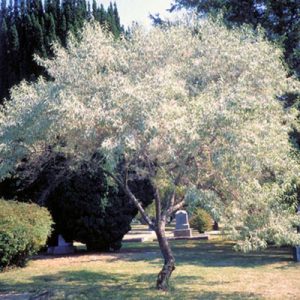
Because Russia covers more than 17 thousand square kilometers of the surface of the Earth, the country has a very rich wildlife with variation of flora and fauna. There are a few zones of vegetation around Russia; the arctic desert on the northernmost part, the tundra that is stretched along the northern part of Asia, the forest zone also known as taiga which covers the majority of Russia, the forest-steppe zone that contributes the best agricultural produce for the country, and the last is the semi-desert zone. Each of the zones has its own unique plants including moss, grasses, shrubs, broadleaf trees, and many more. Just like the fauna, there are also plants native to Russia which one of them is the Russian olive bush, a shrub with unique form and behavior.
The Description
The Latin name for this plant is elaeagnus angustifolia that is commonly known as silver berry or wild olive. It is a small tree that can grow quite tall (up to 10 meters) and works well as a wind breaker. The branches could be thorny and scaly with simple leaves that grow from 3 to 10 centimeters long. The flowers are strongly fragrant and appear in May to June, while the fruits are yellow and covered with scales. Birds love Russian olive’s fruits that make the tree gets easily spread everywhere because of the seeds that get carried by the birds’ droppings.
Russian Olive Bush’s Unique Behavior
In the early 1900s, the tree was thought to be a useful plant that could be used as a soil stablizer and habitat provider. This plant can fix nitrogen in its roots which makes it possible to grow on lands with considerable amounts of saline and alkaline. Russian olive could survive many types of soil including sand and heavy clay. But, because of how easy the seeds of this plant get flown and spread; it can easily escape its designated plot and grow in places where it’s not supposed to. The strength and versatility of the Russian olive would defeat the growth of a place’s native plants and become harmful as well as invasive.
The silvery looks of this plant is completely magical that it seems like coming from an eternal winter land or shrouded by an infrared filter. Sadly, several regions in the world ban this plant from getting imported or planted there because of its destructive manner. In farms, plantation and estates where productive plants are grown, it is important to check the existence of Russian olive trees before they get too tall or the roots too deep for an easier elimination. Other than in Russia, this plant can also be naturally found in Kazakhstan, Turkey, Iran and several parts of Pakistan.
The Use of Russian Olive
The plant is, of course, not completely negative. Like mentioned before, this plant is great to break wind and for cover and protection. Although the leaves can’t provide as food for livestock or big game, the fruits are consumed by more than 50 kinds of birds and mammals. When the plant grows on the river banks, the branches are used by beavers to build dams. The deep root is perfect to prevent erosion in environmentally disturbed lands.
Not only for animals, the fruits of the Russian olive are also beneficial for humans. In Iran, the powder of the dried fruit of this bush plant is mixed with milk to treat rheumatoid arthritis and joint pains. The traditional spring celebration of the Persian, called Nowrus, uses the fruit as one of the seven must-served items on the table. The painkiller effect of the Russian olive fruits is comparable to that of acetaminophen and ibuprofen, studies confirmed. When controlled properly, the Russian olive bush is beautiful for landscape. The green and silvery foliage can reflect light in a mesmerizing way.
Notes for Them Who Wish to Plant the Russian Olive Bush
Despite its obnoxious nature people call invasive, Russian olive is still desired by many people to decorate their yards. If you are one of these people, there are some things you need to know prior to planting it:
1. It is not the easiest species to plant. Buy the small ones because the bigger ones will ask for more soil around the roots.
2. Choose the right spot for it; a spot that you are sure will be the plant’s permanent place for years to come because as it gets bigger, the root will be so deep that it is so difficult to be pulled out – most of the time it needs to be bulldozed.
3. The trunks of Russian olive trees tend to lean as far as 45 degrees as it grows older; sometimes they even get to lean on the ground. To some people, this will add to the beauty of the trees, but consideration should be made before planting it; provide enough space around it to avoid it from crushing into other plants.
4. Although this plant is strong and can thrive on many types of soil, it will show the full potential when getting enough sun light and water – just like most plants would. The color of the leaves will be more beautiful and the flowers will be more fragrant.
5. Russian olive bush sheds annually, so it is quite a low-maintenance plant.
6. Aphid is the only insect that would damage this Russian plant, especially in late autumn. But it is a situation that can easily be corrected by contact insect poison.
If you were wondering why the plant is called Russian olive, well it is because the fruits look just like olives although they don’t taste as good as the ones you would have in your cocktails. So that was the interesting facts about Russian olive bush, a shrub with unique form and behavior.
